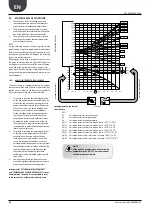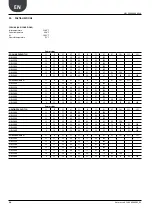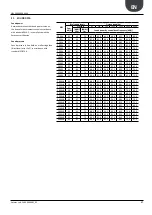
24
Aermec cod. 14.09 4086982_03
NRL 2000-3600 60Hz
EN
•
The correction factors of cooling power and
input power take into account the presence of
glycol and diverse evaporation temperatures.
•
The pressure drop correction factor considers
the different flow rate resulting from the applica
-
tion of the water flow rate correction factor.
•
The water flow rate correction factor is calcula
-
ted to keep the same Δt that would be present
with the absence of glycol.
NOTE
On the following page an example is given to help
graph reading. Using the diagram below it is possible to
determine the percentage of glycol required; this per-
centage can be calculated by taking of the following
factors into consideration one:
Depending on which fluid is considered (water or air),
the graph is interpreted by the right or left side at the
crossing point on the curves with the external tempe-
rature line or the water produced line. A point from
which the vertical line will pass is obtained and this will
distinguish both glycol percentage and relative correc-
tion coefficients.
14.5.
HOW TO INTERPRET GLYCOL CURVES
The curves shown in the diagram summarise a signifi-
cant number of data, each of which is represented by a
specific curve. In order to use these curves correctly it
is first necessary to make some initial reflections.
1.
If you wish to calculate the percentage of glycol
on the basis of the external air temperature, en-
ter from the left axis and on reaching the curve
draw a vertical line, which in turn will intercept
all the other curves; the points obtained from
the upper curves represent the coefficients
for the correction of the cooling capacity and
input power, the flow rates and the pressure
drops (remember that these coefficients must
be multiplied by the nominal value of the size
in question); while the glycol percentage value
recommended to produce desired water tempe-
rature is on the lower axis.
2.
If you wish to calculate the percentage of glycol
on the basis of the temperature of the water
produced, enter from the right axis and on
reaching the curve draw a vertical line, which
in turn will intercept all the other curves; the
points obtained from the upper curves represent
the coefficients for the correction of the cooling
capacity and input power, the flow rates and
the pressure drops (remember that these
coefficients must be multiplied by the nominal
value of the
3.
size in question); while the lower axis recom
-
mends the glycol percentage value necessary to
produce water at the desired temperature.
Initial rates for “EXTERNAL AIR TEMPERATURE”
and “TEMPERATURE OF PRODUCED WATER”, are not
directly related, therefore it is not possible to refer
to the curve of one of these rates to obtain corre-
sponding point on the curve of
the other rate.
15.
ETHYLENE GLYCOL SOLUTIONS
KEY:
Pc
Corrective factors for cooling capacity
Pe
Corrective factors of the input power
Ph
Corrective factors of heating capacity
Δ
P (1)
Correction factors for pressure drop av. temp. = 25,7°F / -3,5°C
Δ
P (2)
Correction factors for pressure drop av. temp. = 32,9°F / 0,5°C
Δ
P (3)
Correction factors for pressure drop av. temp. = 41,9°F / 5,5°C
Δ
P (4)
Correction factors for pressure drop av. temp. = 49,1°F / 9,5°C
Δ
P (5)
Correction factors for pressure drop av. temp. = 117,5°F / 47,5°C
Qw (1)
Correction factor of flow rates (evap.) av. temp = 49,1°F / 9,5°C
Qw (2)
Correction factor of flow rates (cond.) av. temp = 117,5°F / 47,5°C
NOTE
Although the graph arrives at external air
temperatures of -40°C/°F, unit operational
limits must be considered.
2.20
2.10
2.00
1.90
1.80
1.70
1.60
1.50
1.40
1.30
1.20
1.10
1.00
0.99
0.98
0.97
0.96
0.95
0.94
5
0
-5
-10
-15
-20
-25
-30
-35
-40
41
32
23
14
5
-4
-13
-22
-31
-40
(°C)
(°F)
0
5
10
15
20
25
30
35
40
45
50
55
-6
0
5
21.2
32.0
41.0
0.975
0.990
1.000
1.090
1.110
1.180
1.280
1.310
1.390
-3
Pc
Ph
Qw (2)
Qw (1)
∆
P (5)
∆
P (4)
∆
P (3)
∆
P (2)
∆
P (1)
Pe
(°C)
(°F)
Pr
ocessed w
a
ter t
emper
a
tur
e
Corr
ection f
act
or
s
Outside air t
emper
a
tur
e
% Glycol







































